 We had to get up early today for our visit to the Great Wall of China (萬里長城). The day before, we booked seats with the travel agent in our hotel for a package tour to the Great Wall and Ming Tombs (明朝十三陵). The price was RMB150 which we felt was a good deal since it included transportation, entrance to the sites, and lunch.
We had to get up early today for our visit to the Great Wall of China (萬里長城). The day before, we booked seats with the travel agent in our hotel for a package tour to the Great Wall and Ming Tombs (明朝十三陵). The price was RMB150 which we felt was a good deal since it included transportation, entrance to the sites, and lunch.
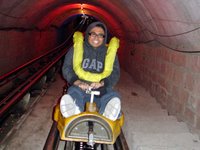 There were optional fees which included RMB60 for a slide car ride up the mountain and down back; as well as RMB40 for extra sites which we could not get the agency to explain in English. So we opted for the slide car ride. Another option up the mountain was a cable car ride but the tour they offered did not have that option since the drop off point for the cable car was in another part of the Great Wall.
There were optional fees which included RMB60 for a slide car ride up the mountain and down back; as well as RMB40 for extra sites which we could not get the agency to explain in English. So we opted for the slide car ride. Another option up the mountain was a cable car ride but the tour they offered did not have that option since the drop off point for the cable car was in another part of the Great Wall.
 Anyway, the bus passed by for us in the hotel at 7:15 a.m. and there were already other passengers. The sad thing was the guide was speaking in Chinese since it turns out, we were the only foreigners on the bus.
Anyway, the bus passed by for us in the hotel at 7:15 a.m. and there were already other passengers. The sad thing was the guide was speaking in Chinese since it turns out, we were the only foreigners on the bus.
On the way, one of the passengers started a shouting match with the guide. We had figured that it had something to do with the payment since the guides were doing rounds of the passengers collecting money. It turns out, the optional fees were not optional and they were collecting the said fees from those who did not pay. So that’s why one of the passengers got hysterical since she thought it was optional and didn’t want to pay for it. So we too had to pay the RMB40 which we opted not to take. Oh well!
 The northern pass of Juyongguan Pass is known as Badaling. This particular area of the Great Wall is the most visited by tourists. This portion of the Great Wall is 7.8 meters high and 5 meters wide.
The northern pass of Juyongguan Pass is known as Badaling. This particular area of the Great Wall is the most visited by tourists. This portion of the Great Wall is 7.8 meters high and 5 meters wide.
As we neared Badaling, the view outside of the tall mountains and traces of the Great Wall was just awe-inspiring. When we exited the bus at the drop off point, a gush of frigid wind hit us. We completely forgot that it was much colder here than the city proper since we were high up in the mountains. It was so cold that I had to put on my hood to keep my ears warm. I should have purchased gloves the day before since the stalls were selling them at exorbitantly high prices. So I had to make do with the pouch in my sweater to keep my hands warm.
 The Great Wall of China (萬里長城) was built to protect the various dynasties from raids by Hunnic, Mongol, Turkic, and other nomadic tribes coming from areas in modern-day Mongolia and Manchuria. Although several walls were built since the 3rd century BC, the most famous being built between 220 BC and 200 BC by the first emperor of China, Qin Shi Huang, little of those earlier walls remain. It is the world's longest man-made structure, stretching over 6,352 kilometers. Mao Zedong had a saying: 不到長城非好漢, "You're not a hero if you haven't climbed the Great Wall."
The Great Wall of China (萬里長城) was built to protect the various dynasties from raids by Hunnic, Mongol, Turkic, and other nomadic tribes coming from areas in modern-day Mongolia and Manchuria. Although several walls were built since the 3rd century BC, the most famous being built between 220 BC and 200 BC by the first emperor of China, Qin Shi Huang, little of those earlier walls remain. It is the world's longest man-made structure, stretching over 6,352 kilometers. Mao Zedong had a saying: 不到長城非好漢, "You're not a hero if you haven't climbed the Great Wall."
 We boarded the slide cars up the mountain which brought us straight to the entrance of the Great Wall. This was the third UNESCO World Heritage Site I visited in just two days. I guess my high spirits just overtook me as I walked the wall and I didn’t realize I had walked a long distance already. The wall stretched as far as the eye could see. The experience was just surreal.
We boarded the slide cars up the mountain which brought us straight to the entrance of the Great Wall. This was the third UNESCO World Heritage Site I visited in just two days. I guess my high spirits just overtook me as I walked the wall and I didn’t realize I had walked a long distance already. The wall stretched as far as the eye could see. The experience was just surreal.
 The guides gave us an hour and a half to do our thing. Then we were off to the next destination. I thought our next stop was lunch but we were herded into a jewelry shop, and after that, a sort of food supermarket which sold vacuum-packed Peking duck, dried fruits, pastries and breads and the like. Lunch was beside the supermarket which I was not satisfied with since it was mostly rice and vegetables. So I ended up buying corn and a grilled sausage from the vendors outside.
The guides gave us an hour and a half to do our thing. Then we were off to the next destination. I thought our next stop was lunch but we were herded into a jewelry shop, and after that, a sort of food supermarket which sold vacuum-packed Peking duck, dried fruits, pastries and breads and the like. Lunch was beside the supermarket which I was not satisfied with since it was mostly rice and vegetables. So I ended up buying corn and a grilled sausage from the vendors outside.
I would later read in Wikitravel a warning about tours being touted in the Forbidden City area with prices between RMB100 to 150 since these tours earned from commissions from all these outlets they bring their passengers to. Although ours was legitimate since it came from our hotel travel agency, I figured our tour was cheap since they earned if any of the passengers bought from the shops they brought us to.
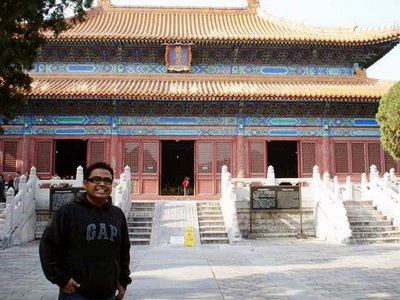 After lunch, we went to one of the Ming Tombs (明朝十三陵). There are thirteen imperial tombs of the Ming Dynasty scattered in an area of about 40 square kilometers in the Changping District of Beijing. They were inscribed in the UNESCO World Heritage List in 2003.
After lunch, we went to one of the Ming Tombs (明朝十三陵). There are thirteen imperial tombs of the Ming Dynasty scattered in an area of about 40 square kilometers in the Changping District of Beijing. They were inscribed in the UNESCO World Heritage List in 2003.
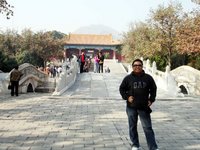 It was the Yongle Emperor, the third Ming emperor, who chose the site of the Ming Tombs. Ruling from 1402 to 1424, he was responsible for moving the capital from Nanjing to Beijing and is credited with envisioning the layout of the ancient city of Beijing. After the construction of the Forbidden City in 1420, Yongle selected his burial site and created his own mausoleum. All in all, 13 out of 16 Ming Dynasty emperors were buried in the area. The tombs of the first two Ming Emperors are located near Nanjing, the capital city during their reigns.
It was the Yongle Emperor, the third Ming emperor, who chose the site of the Ming Tombs. Ruling from 1402 to 1424, he was responsible for moving the capital from Nanjing to Beijing and is credited with envisioning the layout of the ancient city of Beijing. After the construction of the Forbidden City in 1420, Yongle selected his burial site and created his own mausoleum. All in all, 13 out of 16 Ming Dynasty emperors were buried in the area. The tombs of the first two Ming Emperors are located near Nanjing, the capital city during their reigns.
 Only three tombs are open to the public namely Changling, Dingling and Zhaoling. Of these, only the tumulus (underground chamber) of the Dingling Tomb has been opened. Chinese archaeologists are excited about opening the Changling tumulus housing the powerful Yongle Emperor and possibly containing the remaining copy of the Great Dictionary of Yongle (Yongle Dadian).
Only three tombs are open to the public namely Changling, Dingling and Zhaoling. Of these, only the tumulus (underground chamber) of the Dingling Tomb has been opened. Chinese archaeologists are excited about opening the Changling tumulus housing the powerful Yongle Emperor and possibly containing the remaining copy of the Great Dictionary of Yongle (Yongle Dadian).
We visited the Zhaoling Tomb (昭陵)
of Zhu Zaihou (朱載垕), also known as Emperor Muzong (穆宗) or the Longqing Emperor (隆慶) and his three empresses. His reign lasted only six years from1566 to 1572. It wasn't the best of the Ming Tombs though and I felt our guides were just being wise since it had the cheapest entrance fee at RMB30. As they say, "If you've seen one, you've seen them all." Hehe!
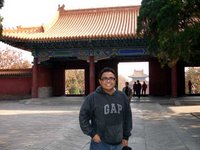 Anyway, after a brief tour of the tomb, we were back to the bus. I was expecting that the extra site was another Ming Tomb but instead they brought us to a wax museum about the Ming Dynasty. Since I’ve seen so many museums before, I would have wanted to stay in the bus and save my money but the guide refused since I think they paid a group rate. So obviously, they were also able to earn from that.
Anyway, after a brief tour of the tomb, we were back to the bus. I was expecting that the extra site was another Ming Tomb but instead they brought us to a wax museum about the Ming Dynasty. Since I’ve seen so many museums before, I would have wanted to stay in the bus and save my money but the guide refused since I think they paid a group rate. So obviously, they were also able to earn from that.
But the museum was not bad since the life-size dioramas were really great and thanks to the English translations of the various scenes, I was able to learn a lot. It was just that I would have wanted to spend the RMB40 on another Ming Tomb.
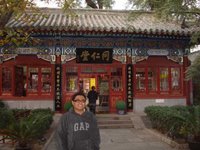 With that done, the group went back to central Beijing. I thought the tour was over but they brought us to one last stop. We went to a traditional Chinese drugstore next which was called the Beijing Tongrentang. I felt it was consistent with the Wikitravel warning. Hehe! They were giving a lecture but it was in Chinese so we were able to excuse ourselves from the sales talk which I felt they were doing in there. But the building had a lot of history since it provided medicine for royalty since 1723. It even had the golden dragon on its ceiling, a sign that it served the emperor.
With that done, the group went back to central Beijing. I thought the tour was over but they brought us to one last stop. We went to a traditional Chinese drugstore next which was called the Beijing Tongrentang. I felt it was consistent with the Wikitravel warning. Hehe! They were giving a lecture but it was in Chinese so we were able to excuse ourselves from the sales talk which I felt they were doing in there. But the building had a lot of history since it provided medicine for royalty since 1723. It even had the golden dragon on its ceiling, a sign that it served the emperor.
On the way to the Tongrentang, we saw a tourist information office right beside what looked like Beihai Park. So we told the guides that we would stay behind. From there, we walked towards the office and asked some questions. Got myself a better map of Beijing. Rhea and Marlon wanted to go shopping since it was their last chance. While I wanted to check out the park. So from there, we parted ways and did our own thing.
 Beijing (北京) is the capital of the People's Republic of China. It is the political, cultural, domestic and international exchange center of the country and one of the largest historical and cultural cities and ancient capitals in the world. Man first appeared in Beijing 700,000 years ago as evidenced by the primitive Peking Man community in Zhoukoudian.We arrived in Beijing at 5:41 a.m. I'd say the temperature was close to 15 degrees Celsius. The trains are very efficient, departing on the dot and arriving on time. First on the list of things to do was to find a hotel for us to freshen up and drop off our luggage. A lot of hotel agents would approach passengers like us for hotel accommodations. After I purchased my train ticket, another approached us but had our ears this time since we just wanted to get it off our minds. So when we asked about the price and we felt the deal was good, we said yes.
Beijing (北京) is the capital of the People's Republic of China. It is the political, cultural, domestic and international exchange center of the country and one of the largest historical and cultural cities and ancient capitals in the world. Man first appeared in Beijing 700,000 years ago as evidenced by the primitive Peking Man community in Zhoukoudian.We arrived in Beijing at 5:41 a.m. I'd say the temperature was close to 15 degrees Celsius. The trains are very efficient, departing on the dot and arriving on time. First on the list of things to do was to find a hotel for us to freshen up and drop off our luggage. A lot of hotel agents would approach passengers like us for hotel accommodations. After I purchased my train ticket, another approached us but had our ears this time since we just wanted to get it off our minds. So when we asked about the price and we felt the deal was good, we said yes. They had a vehicle which took us to the hotel which was along Tiāntán Lu (Temple of Heaven Road) and thus, right beside the Temple of Heaven. When we got there, they then let us check the room first which was to me, a sign that they were not the types that would cheat us. The room was actually two rooms with a connecting door so we had four beds and one bathroom for the price of RMB230 a night. Since there were three of us, we ended up spending about RMB75 each. So after getting settled and munching on the food we had left, we were off.First on our list of places to visit was (天坛) Tiāntán or the Temple of Heaven which was right in front of the hotel. But the north entrance was a few minutes walk down the road. It is a UNESCO World Heritage Site, which is one of six inscribed sites in the jurisdiction of Beijing alone.
They had a vehicle which took us to the hotel which was along Tiāntán Lu (Temple of Heaven Road) and thus, right beside the Temple of Heaven. When we got there, they then let us check the room first which was to me, a sign that they were not the types that would cheat us. The room was actually two rooms with a connecting door so we had four beds and one bathroom for the price of RMB230 a night. Since there were three of us, we ended up spending about RMB75 each. So after getting settled and munching on the food we had left, we were off.First on our list of places to visit was (天坛) Tiāntán or the Temple of Heaven which was right in front of the hotel. But the north entrance was a few minutes walk down the road. It is a UNESCO World Heritage Site, which is one of six inscribed sites in the jurisdiction of Beijing alone. The ordinary entrance ticket is RMB10 but this was just so that you could enter the grounds. To enter the major buildings, you would have to get a through ticket which was RMB30.The Temple of Heaven, covering an area of 2.7 million square meters, is the largest extant temple complex in China. First built in 1420, it served as a place for the emperors of the Ming and Qing Dynasties to worship heaven and pray for an abundant harvest. It is famous for its precise layout, unique architectural structures and elegant decorations.On the north end is the Hall of Prayer for a Good Harvest which is the structure we see in most brochures and books. While on the opposite end is the Imperial Vault of Heaven and the Circular Mound Altar. The three structures are perfectly aligned along a north-south axis, connected by a terrace called the divine pavement which is 360 meters long and 2.5 meters high.
The ordinary entrance ticket is RMB10 but this was just so that you could enter the grounds. To enter the major buildings, you would have to get a through ticket which was RMB30.The Temple of Heaven, covering an area of 2.7 million square meters, is the largest extant temple complex in China. First built in 1420, it served as a place for the emperors of the Ming and Qing Dynasties to worship heaven and pray for an abundant harvest. It is famous for its precise layout, unique architectural structures and elegant decorations.On the north end is the Hall of Prayer for a Good Harvest which is the structure we see in most brochures and books. While on the opposite end is the Imperial Vault of Heaven and the Circular Mound Altar. The three structures are perfectly aligned along a north-south axis, connected by a terrace called the divine pavement which is 360 meters long and 2.5 meters high. Some guide books say that the area it covers is twice as large as the Forbidden City. So it is important that you enter through the north or south entrance or you’ll end up wasting a lot of time entering through the sides and see nothing much too.Near the south entrance was a tourist information office. When the staff saw we were approaching, they immediately stood up and met us. We asked which bus we could take to get to Tian’anmen Square (天安門廣場). So they gave us a piece of paper with the bus number and a message in Chinese for the conductor to read. When the conductor read our note, she was very helpful and informed us when to get off. Buses within the city center area have a flat rate of RMB1.
Some guide books say that the area it covers is twice as large as the Forbidden City. So it is important that you enter through the north or south entrance or you’ll end up wasting a lot of time entering through the sides and see nothing much too.Near the south entrance was a tourist information office. When the staff saw we were approaching, they immediately stood up and met us. We asked which bus we could take to get to Tian’anmen Square (天安門廣場). So they gave us a piece of paper with the bus number and a message in Chinese for the conductor to read. When the conductor read our note, she was very helpful and informed us when to get off. Buses within the city center area have a flat rate of RMB1. Most people in China do not speak English. So a Mandarin phrasebook with Chinese characters would come in handy so that you could just point at it when needed. Without the characters, it would be a challenge since intonation is also very important. If you have Chinese friends, you could also ask them to prepare flash cards which you could show when needed; which is what I did for my train ticket, asking our guide in Fuzhou to prepare me a note that I needed a train ticket for Shanghai leaving on November 3.
Most people in China do not speak English. So a Mandarin phrasebook with Chinese characters would come in handy so that you could just point at it when needed. Without the characters, it would be a challenge since intonation is also very important. If you have Chinese friends, you could also ask them to prepare flash cards which you could show when needed; which is what I did for my train ticket, asking our guide in Fuzhou to prepare me a note that I needed a train ticket for Shanghai leaving on November 3.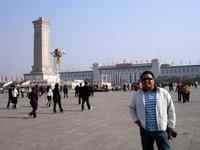 Tian’anmen Square (left) is said to be the largest city center square in the world. It is named after the Tian'anmen Gate (天安門) or Gate of Heavenly Peace. After taking photos at the (前門) Qianmen Gate (above right) which is at the southern end of the square and the Monument to the People's Heroes (人民英雄紀念碑), we proceeded to the (毛主席纪念堂) Chairman Mao Memorial Hall (below right) to view the remains of Mao Zedong.The hall is a square building with 44 octagonal granite pillars. Outside the north and south entrances are two groups of statues 8.7 meters high. The building is solemn and grand with the remains of Chairman Mao enshrined in a crystal coffin in the reverence hall.
Tian’anmen Square (left) is said to be the largest city center square in the world. It is named after the Tian'anmen Gate (天安門) or Gate of Heavenly Peace. After taking photos at the (前門) Qianmen Gate (above right) which is at the southern end of the square and the Monument to the People's Heroes (人民英雄紀念碑), we proceeded to the (毛主席纪念堂) Chairman Mao Memorial Hall (below right) to view the remains of Mao Zedong.The hall is a square building with 44 octagonal granite pillars. Outside the north and south entrances are two groups of statues 8.7 meters high. The building is solemn and grand with the remains of Chairman Mao enshrined in a crystal coffin in the reverence hall.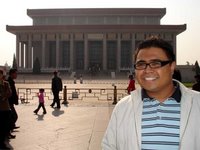 Just a note, you are not allowed to bring bags, more so cameras inside. So you could either ask a companion to wait outside and hold them for you or deposit them in the baggage storage center across the street for a fee. Entrance to the hall however is free. We made it in time since the hall was closing at 11:30 a.m.After visiting the hall, and getting our bags back, we decided to walk around and look for a place to eat lunch. Along the way, we passed by the Beijing 2008 Olympics souvenir shop but didn't get to buy anything since everything was just so pricey!
Just a note, you are not allowed to bring bags, more so cameras inside. So you could either ask a companion to wait outside and hold them for you or deposit them in the baggage storage center across the street for a fee. Entrance to the hall however is free. We made it in time since the hall was closing at 11:30 a.m.After visiting the hall, and getting our bags back, we decided to walk around and look for a place to eat lunch. Along the way, we passed by the Beijing 2008 Olympics souvenir shop but didn't get to buy anything since everything was just so pricey!
 We found a Chinese fast food restaurant where I ordered this round pancake with pork inside which reminded me of murtabak. It was during lunch that Rhea and Marlon decided that they would take a train back to Guangzhou since plane tickets were RMB1,300 one-way. They did not buy tickets when we were at the station in the morning since they wanted to check out flight options. They just could not stand the long travel. But since plane tickets were more than twice the cost of the train, they opted for the latter. So we trooped back to the Beijing Train Station to get their tickets which were about RMB450. Now that the sun was out, we were also able to take photos in front of the train station.
We found a Chinese fast food restaurant where I ordered this round pancake with pork inside which reminded me of murtabak. It was during lunch that Rhea and Marlon decided that they would take a train back to Guangzhou since plane tickets were RMB1,300 one-way. They did not buy tickets when we were at the station in the morning since they wanted to check out flight options. They just could not stand the long travel. But since plane tickets were more than twice the cost of the train, they opted for the latter. So we trooped back to the Beijing Train Station to get their tickets which were about RMB450. Now that the sun was out, we were also able to take photos in front of the train station.
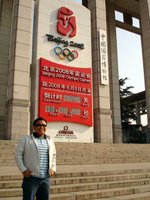 On the way to the subway station, we took photos in front of the Beijing 2008 Olympic Games countdown clock in front of the National Museum of China. The Games are opening at 8 p.m. of August 8, 2008 (8/8/08) since as you all know, "8" is a lucky number for the Chinese.
On the way to the subway station, we took photos in front of the Beijing 2008 Olympic Games countdown clock in front of the National Museum of China. The Games are opening at 8 p.m. of August 8, 2008 (8/8/08) since as you all know, "8" is a lucky number for the Chinese.
I think we were able to troop back to Tian'anmen at 2 p.m. Since we were behind schedule, we rushed to take more photos. And one of them was in front of the Tian'anmen Gate itself, an image of Tian'anmen Square which is familiar all over the world.
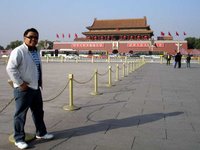 The 33.7 meter-high gate was the original entrance of the imperial city. And it's middle entrance was reserved for the emperor. It was from this gate that emperors announced their edicts.
The 33.7 meter-high gate was the original entrance of the imperial city. And it's middle entrance was reserved for the emperor. It was from this gate that emperors announced their edicts.
With that done, it was time to fulfill my dream of stepping foot in the Forbidden City (紫禁城). Known as the Palace Museum (故宫), the Forbidden City was the residence of 24 emperors of the Ming and Qing Dynasties. It is among the UNESCO World Heritage sites in Beijing.
 Located in the center of the central axial line of Beijing, the imperial palace was first constructed in 1406. It has more than 9,000 palaces, halls and rooms, and contains a large number of valuable cultural relics. The entrance ticket to the palace was RMB40.
Located in the center of the central axial line of Beijing, the imperial palace was first constructed in 1406. It has more than 9,000 palaces, halls and rooms, and contains a large number of valuable cultural relics. The entrance ticket to the palace was RMB40.
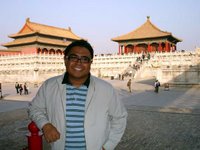 We were warned by our Chinese hosts that many of the structures would be covered by scaffolding since they were restoring the old buildings in time for the Beijing Olympics in 2008. It was good that the restoration work at the Temple of Heaven was already completed which is why if you notice in the photos, the colors of the structures were very vibrant. Some structures in the Forbidden City were also completed.
We were warned by our Chinese hosts that many of the structures would be covered by scaffolding since they were restoring the old buildings in time for the Beijing Olympics in 2008. It was good that the restoration work at the Temple of Heaven was already completed which is why if you notice in the photos, the colors of the structures were very vibrant. Some structures in the Forbidden City were also completed.
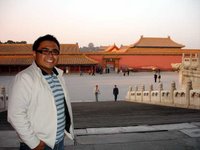 As we entered the gates of the main palace complex, I could hear the opening notes of "The Last Emperor" playing in my mind. But the sad part about our visit was the main hall of the palace was completely covered by scaffolding! There goes my photo with the main throne room.
As we entered the gates of the main palace complex, I could hear the opening notes of "The Last Emperor" playing in my mind. But the sad part about our visit was the main hall of the palace was completely covered by scaffolding! There goes my photo with the main throne room.
You'd know if restoration on a structure was completed by the colors. The structures above have yet to be restored. While the one below is already done.
 We stayed until closing time, visiting as many sites as we could since the palace complex was just so vast. From the Palace Museum, we took a walk towards the southern end of Tian'anmen where there was an internet shop.
We stayed until closing time, visiting as many sites as we could since the palace complex was just so vast. From the Palace Museum, we took a walk towards the southern end of Tian'anmen where there was an internet shop.
The regular internet shops are regulated by the government requiring ID cards before you could use them. This was to prevent minors from getting hooked to online gaming. But for tourist internet shops, they weren't too strict about IDs since the catch was the prices were sky high! They charged RMB20 per hour which was roughly PHP130.
Tomorrow we visit the Great Wall of China!
 There is a lot to be said about trains in China, especially if you are on one for 34 hours! We got ourselves hard sleeper tickets to Beijing. There are two other options which are the ordinary seats for shorter trips (now try that for 34 hours) and the soft sleepers which was sort of the first class tickets.Although called hard sleepers, the beds are not really that hard. There are six beds in each cabin, two on the ground level, two middle bunks and two on top. Prices slightly differ depending on the level. The ground level tickets from Fuzhou to Beijing were RMB458 while a middle bunk was about RMB15 cheaper. I wasn’t able to find out how much a top bunk costs.For the soft sleepers, there are just four beds to a cabin. The cabins seem slightly bigger and the beds are obviously softer. Aside from better beds and sheets, the ambiance is different since in the soft sleeper cabins, incandescent lights are used unlike the hard sleeper cabins which use fluorescent lights. The rest rooms are cleaner too. But tickets cost 40 to 50 percent more than the hard sleeper.
There is a lot to be said about trains in China, especially if you are on one for 34 hours! We got ourselves hard sleeper tickets to Beijing. There are two other options which are the ordinary seats for shorter trips (now try that for 34 hours) and the soft sleepers which was sort of the first class tickets.Although called hard sleepers, the beds are not really that hard. There are six beds in each cabin, two on the ground level, two middle bunks and two on top. Prices slightly differ depending on the level. The ground level tickets from Fuzhou to Beijing were RMB458 while a middle bunk was about RMB15 cheaper. I wasn’t able to find out how much a top bunk costs.For the soft sleepers, there are just four beds to a cabin. The cabins seem slightly bigger and the beds are obviously softer. Aside from better beds and sheets, the ambiance is different since in the soft sleeper cabins, incandescent lights are used unlike the hard sleeper cabins which use fluorescent lights. The rest rooms are cleaner too. But tickets cost 40 to 50 percent more than the hard sleeper. Now back to the hard sleepers. Each bunk is given a pillow and a comforter and has its own reading light. In each cabin is a thermos for hot water which is an essential since most passengers have instant noodles for their meals as well as tea. There is a restaurant on board but food is quite pricey. Each carriage has common squat toilets, lavatories as well as a continuous supply of potable hot water.Outside each cabin was a sort of table for eating and two retractable seats which are mostly for those in the upper bunks since you wouldn’t have a chance to sit down except if the one occupying the ground level bunk was your companion like in my case.
Now back to the hard sleepers. Each bunk is given a pillow and a comforter and has its own reading light. In each cabin is a thermos for hot water which is an essential since most passengers have instant noodles for their meals as well as tea. There is a restaurant on board but food is quite pricey. Each carriage has common squat toilets, lavatories as well as a continuous supply of potable hot water.Outside each cabin was a sort of table for eating and two retractable seats which are mostly for those in the upper bunks since you wouldn’t have a chance to sit down except if the one occupying the ground level bunk was your companion like in my case.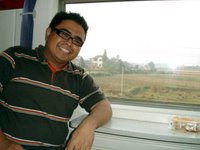 Once the train moves, the attendants do rounds of the cabins to collect the tickets and in return, give each passenger a plastic card corresponding to his or her bunk. This card is returned to the attendant shortly before reaching your destination and the attendant returns your ticket to you. You need to show the ticket when you exit the train station.The good thing about the plastic card practice is that the attendants are able to monitor the final destinations of each passenger and wake sleeping passengers up when they are nearing their destination in order to retrieve the plastic card. Thus, passengers do not miss their stops especially since the train arrives in the early hours of the morning in some stops.The long trip wasn’t bad at all. In fact, it was an opportunity for us to relax after the tight schedule of the camp. And the good thing about the trip was that we got to see the Chinese countryside. I was able to sleep quite well since the train moved smoothly and wasn’t shaking as much as we thought it would. And the irony was that I would wake up when the train stopped at a station which to me was weird since the train wasn’t moving at all.Well before we knew it, the train attendants woke us up since we were nearing Beijing.The first thing I did as soon as we arrived was to buy my ticket to Shanghai. The thing about China trains was that you could not book return tickets or tickets from other destinations since you had to buy your ticket from the station from which the train left. So tickets from Beijing to Shanghai had to be purchased in Beijing while my ticket from Shanghai back to Guangzhou had to be purchased in Shanghai.Now the problem there is the fact that you have to buy your tickets way in advance since the trips are usually fully-booked. So when I checked the ticket office, there were no more hard sleepers, just soft sleepers. So I had no choice but to get it which was okay with me since at least I could experience it too. I spent RMB499 for it, while a hard sleeper was about RMB150 less.
Once the train moves, the attendants do rounds of the cabins to collect the tickets and in return, give each passenger a plastic card corresponding to his or her bunk. This card is returned to the attendant shortly before reaching your destination and the attendant returns your ticket to you. You need to show the ticket when you exit the train station.The good thing about the plastic card practice is that the attendants are able to monitor the final destinations of each passenger and wake sleeping passengers up when they are nearing their destination in order to retrieve the plastic card. Thus, passengers do not miss their stops especially since the train arrives in the early hours of the morning in some stops.The long trip wasn’t bad at all. In fact, it was an opportunity for us to relax after the tight schedule of the camp. And the good thing about the trip was that we got to see the Chinese countryside. I was able to sleep quite well since the train moved smoothly and wasn’t shaking as much as we thought it would. And the irony was that I would wake up when the train stopped at a station which to me was weird since the train wasn’t moving at all.Well before we knew it, the train attendants woke us up since we were nearing Beijing.The first thing I did as soon as we arrived was to buy my ticket to Shanghai. The thing about China trains was that you could not book return tickets or tickets from other destinations since you had to buy your ticket from the station from which the train left. So tickets from Beijing to Shanghai had to be purchased in Beijing while my ticket from Shanghai back to Guangzhou had to be purchased in Shanghai.Now the problem there is the fact that you have to buy your tickets way in advance since the trips are usually fully-booked. So when I checked the ticket office, there were no more hard sleepers, just soft sleepers. So I had no choice but to get it which was okay with me since at least I could experience it too. I spent RMB499 for it, while a hard sleeper was about RMB150 less.
 It’s our last day in Fuzhou. The program officially ended yesterday and the delegates will be heading home today. Our breakfast call time was 5:30 a.m. since the group had to leave by 6:10 a.m. to catch the flight back to Guangzhou.I was tired and sleepy from the previous night. After the farewell dinner, our Fujian hosts took the national leaders out for supper (meaning more food and drinks) at a hotel owned by one of the sponsors. And to think I was still stuffed from the lavish banquet prepared for us just two hours earlier.During supper, I had several shots of Chivas Regal since in China, it is rude to refuse a toast, more so from the hosts. And it is customary to reciprocate by offering a toast as well. When I got back to the hotel, I still did not go to bed since I joined the Singapore contingent at the KTV in the mezzanine for more drinks and some singing. Hehe! When the KTV closed at 2 a.m., I was still up since we were still chatting with other delegates in the room. I just remember that I could no longer keep my eyes open since we had been up late the previous nights, so I just excused myself and went straight to bed.
It’s our last day in Fuzhou. The program officially ended yesterday and the delegates will be heading home today. Our breakfast call time was 5:30 a.m. since the group had to leave by 6:10 a.m. to catch the flight back to Guangzhou.I was tired and sleepy from the previous night. After the farewell dinner, our Fujian hosts took the national leaders out for supper (meaning more food and drinks) at a hotel owned by one of the sponsors. And to think I was still stuffed from the lavish banquet prepared for us just two hours earlier.During supper, I had several shots of Chivas Regal since in China, it is rude to refuse a toast, more so from the hosts. And it is customary to reciprocate by offering a toast as well. When I got back to the hotel, I still did not go to bed since I joined the Singapore contingent at the KTV in the mezzanine for more drinks and some singing. Hehe! When the KTV closed at 2 a.m., I was still up since we were still chatting with other delegates in the room. I just remember that I could no longer keep my eyes open since we had been up late the previous nights, so I just excused myself and went straight to bed.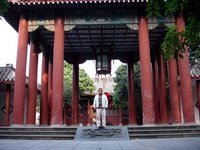 Although I did not have to wake up early since three of us were staying to catch an evening train to Beijing, I did anyway to say goodbye to everyone. It reminded me so much of SSEAYP since I also stayed behind in Singapore then since each participating country left a representative to attend the World Youth Meeting with delegates of the Ship for World Youth (SWY). It was funny watching everyone board the buses and waving as the buses left since it was as if we were just home and saying goodbye to our guests.
Although I did not have to wake up early since three of us were staying to catch an evening train to Beijing, I did anyway to say goodbye to everyone. It reminded me so much of SSEAYP since I also stayed behind in Singapore then since each participating country left a representative to attend the World Youth Meeting with delegates of the Ship for World Youth (SWY). It was funny watching everyone board the buses and waving as the buses left since it was as if we were just home and saying goodbye to our guests. Anyway, I went straight to bed right after. Next thing I knew it was time for lunch so I packed my stuff and met up with the others at the restaurant below. We were planning to go to around in the afternoon. But shock hit us when we asked our guide Justin what time we would arrive in Beijing.Fuzhou is closer to Beijing than Guangzhou. We knew that the train from Guangzhou would take about 22 hours. And we were told that it would thus be shorter if we left from Fuzhou. So when Justin told us it was 34 hours, we just stood there in disbelief. It turns out, trains from this part of China had to navigate through mountains and thus, it took longer. Sigh! I just told the other two that the good thing about the situation was that instead of arriving in Beijing in the evening and having to spend for a hotel, we were going to arrive at 6 a.m. and thus, after freshening up, could already go around since we would have had enough sleep.
Anyway, I went straight to bed right after. Next thing I knew it was time for lunch so I packed my stuff and met up with the others at the restaurant below. We were planning to go to around in the afternoon. But shock hit us when we asked our guide Justin what time we would arrive in Beijing.Fuzhou is closer to Beijing than Guangzhou. We knew that the train from Guangzhou would take about 22 hours. And we were told that it would thus be shorter if we left from Fuzhou. So when Justin told us it was 34 hours, we just stood there in disbelief. It turns out, trains from this part of China had to navigate through mountains and thus, it took longer. Sigh! I just told the other two that the good thing about the situation was that instead of arriving in Beijing in the evening and having to spend for a hotel, we were going to arrive at 6 a.m. and thus, after freshening up, could already go around since we would have had enough sleep. With that settled, we decided to shop for food for the 34 hour trip. But we decided to visit West Lake Park first which was just beside the hotel. The main attraction of the park is the two islands in the middle of the lake connected by old bridges. On one island was the sprawling villa of some rich person who lived several hundred years back.While walking around, we noticed some people in Chinese costumes from the imperial court. It turns out, the costumes were for rent. And excited to try them out, we went straight to the shop to find out that the rental fee was just RMB5 or roughly PHP35! Just great!
With that settled, we decided to shop for food for the 34 hour trip. But we decided to visit West Lake Park first which was just beside the hotel. The main attraction of the park is the two islands in the middle of the lake connected by old bridges. On one island was the sprawling villa of some rich person who lived several hundred years back.While walking around, we noticed some people in Chinese costumes from the imperial court. It turns out, the costumes were for rent. And excited to try them out, we went straight to the shop to find out that the rental fee was just RMB5 or roughly PHP35! Just great!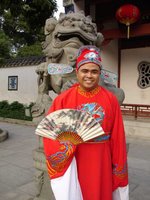 Although wearing the attire of the emperor would have been nice, I decided to wear a red robe because of the hat which accompanied it. It was the one with those propeller-like things sticking out of them. Hehe! I remember seeing them when I was a small kid watching those Chinese movies they played on local television long before. Turns out, it was worn by a member of the court who had topped the examination. We were kidding that when everyone else who had gone home found out about the costume shop, they would feel bad since it was right at the door step of the hotel.
Although wearing the attire of the emperor would have been nice, I decided to wear a red robe because of the hat which accompanied it. It was the one with those propeller-like things sticking out of them. Hehe! I remember seeing them when I was a small kid watching those Chinese movies they played on local television long before. Turns out, it was worn by a member of the court who had topped the examination. We were kidding that when everyone else who had gone home found out about the costume shop, they would feel bad since it was right at the door step of the hotel. After the fun photo shoot, we rushed to the supermarket to get our food supplies. I got myself some bread with shredded pork, cup noodles, canned pork and 4 liters of water. I planned my menu in such a way that the heavy stuff was for when we were nearing Beijing so that I didn’t have to use the squat toilets while on the train. Haha!We went back to the hotel for dinner, still courtesy of our hosts, and to get our luggage. A vehicle was also arranged for us to take us to the train station. But as soon as we get on the train, we are on our own.
After the fun photo shoot, we rushed to the supermarket to get our food supplies. I got myself some bread with shredded pork, cup noodles, canned pork and 4 liters of water. I planned my menu in such a way that the heavy stuff was for when we were nearing Beijing so that I didn’t have to use the squat toilets while on the train. Haha!We went back to the hotel for dinner, still courtesy of our hosts, and to get our luggage. A vehicle was also arranged for us to take us to the train station. But as soon as we get on the train, we are on our own.
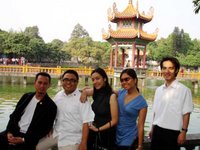 Today, we had a chance to go around Fuzhou, which is referred to as Rongcheng or the City of Banyan Trees which were planted in the city at the time of the Northern Song Dynasty (960-1127). First on our itinerary today was a visit to the Xichan Temple. Finally, after our close to a week's stay in China, we get to visit a centuries-old cultural structure. Good news for a heritage buff! Hehe! The temple was said to have been built in 867 A.D.
Today, we had a chance to go around Fuzhou, which is referred to as Rongcheng or the City of Banyan Trees which were planted in the city at the time of the Northern Song Dynasty (960-1127). First on our itinerary today was a visit to the Xichan Temple. Finally, after our close to a week's stay in China, we get to visit a centuries-old cultural structure. Good news for a heritage buff! Hehe! The temple was said to have been built in 867 A.D.
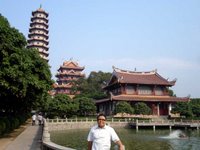 According to sources, the temple is in the west of Fuzhou, on the foot of Mount Yi. An ancient temple of the Tang Dynasty (618-907), Xichan is one of five Buddhist temples in the city. The most visible structure is its tall pagoda. Another feature of the temple is the many Litchi trees, planted in the Song Dynasty (960-1279). The visit to the temple was a good opportunity for many of us to relax and enjoy Chinese heritage, and for some of us, to retreat and reflect.
According to sources, the temple is in the west of Fuzhou, on the foot of Mount Yi. An ancient temple of the Tang Dynasty (618-907), Xichan is one of five Buddhist temples in the city. The most visible structure is its tall pagoda. Another feature of the temple is the many Litchi trees, planted in the Song Dynasty (960-1279). The visit to the temple was a good opportunity for many of us to relax and enjoy Chinese heritage, and for some of us, to retreat and reflect.
After the short tour, we then visited some enterprises based in Fuzhou such as the Fujian Jindeli Holdings Corporation which produces jewelry, as well as the Fujian Star-net Communications Company. Lunch was at the Rongquiao Riverview Hotel were a huge buffet awaited us. There was just too much food from the usual Chinese food, to sushi, shabu-shabu, and grilled meats. I really had to control my appetite since I didn't want to gain weight during the trip. Hehe!
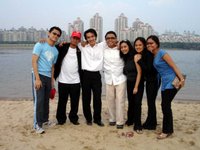 This was followed by a visit to the Ninghua Youth Civilization Community to observe volunteer work being done by the group in a community composed mostly of senior citizens. Again, the main discussion point of the camp was volunteerism and I do hope we could strengthen that here.
This was followed by a visit to the Ninghua Youth Civilization Community to observe volunteer work being done by the group in a community composed mostly of senior citizens. Again, the main discussion point of the camp was volunteerism and I do hope we could strengthen that here.
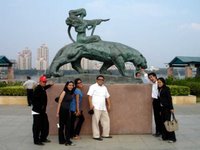 Our last stop was a few minutes at the Fuzhou Riverside Park. There are just so many parks and open spaces in China. Really great for the standard of living. In Metro Manila, we only have a few open spaces left and some mayor is even attempting to chop down the last urban forest in his jurisdiction. I wonder what runs in his mind when he gets all these crazy ideas. I think mayors here should have the political will to reclaim open spaces such as old plazas and parks that used to be a highlight of Manila at the turn of the past century.
Our last stop was a few minutes at the Fuzhou Riverside Park. There are just so many parks and open spaces in China. Really great for the standard of living. In Metro Manila, we only have a few open spaces left and some mayor is even attempting to chop down the last urban forest in his jurisdiction. I wonder what runs in his mind when he gets all these crazy ideas. I think mayors here should have the political will to reclaim open spaces such as old plazas and parks that used to be a highlight of Manila at the turn of the past century.
 We then trooped back to the hotel to prepare for a very formal courtesy call to the leaders of Fujian province. And just to let you know, Chinese provinces are as big as countries! In fact, the Philippines is just slightly larger than Guangxi. Mainland China, with its land area of 9.5 million square kilometers just has 22 provinces, five autonomous regions and four independent municipalities. In fact, many Chinese cities are bigger than our provinces which I why I wonder where some people in Davao City got the idea that they are the biggest city in the world in terms of land area. Shanghai, China's biggest city, is a little over two times the size of Davao City at 6,340.5 square kilometers.
We then trooped back to the hotel to prepare for a very formal courtesy call to the leaders of Fujian province. And just to let you know, Chinese provinces are as big as countries! In fact, the Philippines is just slightly larger than Guangxi. Mainland China, with its land area of 9.5 million square kilometers just has 22 provinces, five autonomous regions and four independent municipalities. In fact, many Chinese cities are bigger than our provinces which I why I wonder where some people in Davao City got the idea that they are the biggest city in the world in terms of land area. Shanghai, China's biggest city, is a little over two times the size of Davao City at 6,340.5 square kilometers.
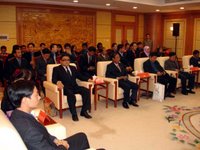 Compare the China figures to the 79 provinces of the Philippines in just 300,000 square kilometers! I feel the Philippines is just too fragmented, where a few small municipalities can constitute a province. As a result, there is no coordinated development effort with each governor having his own preferences, whims and caprices and the result is a chopsuey urban landscape. In fact, as I speak, votes are being counted for the creation of the new province of Shariff Kabunsuan, the 80th province, which is almost sure of approval by Maguindanao voters. Obviously, this creates more positions up for grabs for our politicians. I feel that this practice has to be stopped and that we should be doing the opposite which is fusing together small political units to halt the chopsuey development. Oh well!
Compare the China figures to the 79 provinces of the Philippines in just 300,000 square kilometers! I feel the Philippines is just too fragmented, where a few small municipalities can constitute a province. As a result, there is no coordinated development effort with each governor having his own preferences, whims and caprices and the result is a chopsuey urban landscape. In fact, as I speak, votes are being counted for the creation of the new province of Shariff Kabunsuan, the 80th province, which is almost sure of approval by Maguindanao voters. Obviously, this creates more positions up for grabs for our politicians. I feel that this practice has to be stopped and that we should be doing the opposite which is fusing together small political units to halt the chopsuey development. Oh well!
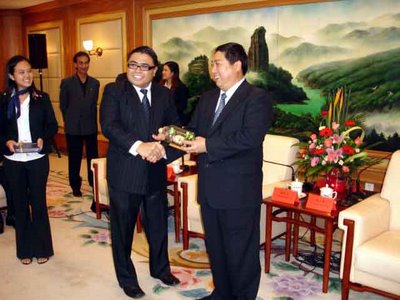 Enough with the digression. So going back, we met up with Mr. Chen Shaoyong, the Secretary-General of the Fujian Provincial Standing Committee of the Communist Party of China, the no. 2 man in Fujian.
Enough with the digression. So going back, we met up with Mr. Chen Shaoyong, the Secretary-General of the Fujian Provincial Standing Committee of the Communist Party of China, the no. 2 man in Fujian.
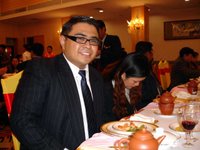 A dinner banquet followed at another five-star hotel. I feel this banquet was the most lavish of them all since they brought out some exotic-looking dishes. Wasn't able to note down all the dishes since the menu was in Chinese.
A dinner banquet followed at another five-star hotel. I feel this banquet was the most lavish of them all since they brought out some exotic-looking dishes. Wasn't able to note down all the dishes since the menu was in Chinese.
This was the last activity of the China-ASEAN Youth Camp 2006 so it served as a farewell party as well. More toasts were exchanged as a tribute to the strong cooperation among nations. To end the evening, the entire ballroom sang the Chinese and original versions of Auld Lang Syne. This song gives me the goosebumps since it was always played for our emotional farewells in the Ship for Southeast Asian Youth Program which I participated in way back in 2002.
 According to sources, the words Auld Lang Syne literally translates from the old Scottish dialect meaning Old Long Ago and is about love and friendship in times past. The part of the song which goes "We'll take a Cup of Kindness yet" relates to a drink shared by men and women to symbolise friendship. So there, a fitting finale to a week of cultural exchange between neighbors.
According to sources, the words Auld Lang Syne literally translates from the old Scottish dialect meaning Old Long Ago and is about love and friendship in times past. The part of the song which goes "We'll take a Cup of Kindness yet" relates to a drink shared by men and women to symbolise friendship. So there, a fitting finale to a week of cultural exchange between neighbors.
Our great China adventure begins tomorrow. While the other delegates go back home to their own countries, three of us decided to make the most of our China trip by visiting Beijing.
 We had to get up early today for our visit to the Great Wall of China (萬里長城). The day before, we booked seats with the travel agent in our hotel for a package tour to the Great Wall and Ming Tombs (明朝十三陵). The price was RMB150 which we felt was a good deal since it included transportation, entrance to the sites, and lunch.
We had to get up early today for our visit to the Great Wall of China (萬里長城). The day before, we booked seats with the travel agent in our hotel for a package tour to the Great Wall and Ming Tombs (明朝十三陵). The price was RMB150 which we felt was a good deal since it included transportation, entrance to the sites, and lunch. There were optional fees which included RMB60 for a slide car ride up the mountain and down back; as well as RMB40 for extra sites which we could not get the agency to explain in English. So we opted for the slide car ride. Another option up the mountain was a cable car ride but the tour they offered did not have that option since the drop off point for the cable car was in another part of the Great Wall.
There were optional fees which included RMB60 for a slide car ride up the mountain and down back; as well as RMB40 for extra sites which we could not get the agency to explain in English. So we opted for the slide car ride. Another option up the mountain was a cable car ride but the tour they offered did not have that option since the drop off point for the cable car was in another part of the Great Wall. Anyway, the bus passed by for us in the hotel at 7:15 a.m. and there were already other passengers. The sad thing was the guide was speaking in Chinese since it turns out, we were the only foreigners on the bus.
Anyway, the bus passed by for us in the hotel at 7:15 a.m. and there were already other passengers. The sad thing was the guide was speaking in Chinese since it turns out, we were the only foreigners on the bus. The northern pass of Juyongguan Pass is known as Badaling. This particular area of the Great Wall is the most visited by tourists. This portion of the Great Wall is 7.8 meters high and 5 meters wide.
The northern pass of Juyongguan Pass is known as Badaling. This particular area of the Great Wall is the most visited by tourists. This portion of the Great Wall is 7.8 meters high and 5 meters wide. The Great Wall of China (萬里長城) was built to protect the various dynasties from raids by Hunnic, Mongol, Turkic, and other nomadic tribes coming from areas in modern-day Mongolia and Manchuria. Although several walls were built since the 3rd century BC, the most famous being built between 220 BC and 200 BC by the first emperor of China, Qin Shi Huang, little of those earlier walls remain. It is the world's longest man-made structure, stretching over 6,352 kilometers. Mao Zedong had a saying: 不到長城非好漢, "You're not a hero if you haven't climbed the Great Wall."
The Great Wall of China (萬里長城) was built to protect the various dynasties from raids by Hunnic, Mongol, Turkic, and other nomadic tribes coming from areas in modern-day Mongolia and Manchuria. Although several walls were built since the 3rd century BC, the most famous being built between 220 BC and 200 BC by the first emperor of China, Qin Shi Huang, little of those earlier walls remain. It is the world's longest man-made structure, stretching over 6,352 kilometers. Mao Zedong had a saying: 不到長城非好漢, "You're not a hero if you haven't climbed the Great Wall." We boarded the slide cars up the mountain which brought us straight to the entrance of the Great Wall. This was the third UNESCO World Heritage Site I visited in just two days. I guess my high spirits just overtook me as I walked the wall and I didn’t realize I had walked a long distance already. The wall stretched as far as the eye could see. The experience was just surreal.
We boarded the slide cars up the mountain which brought us straight to the entrance of the Great Wall. This was the third UNESCO World Heritage Site I visited in just two days. I guess my high spirits just overtook me as I walked the wall and I didn’t realize I had walked a long distance already. The wall stretched as far as the eye could see. The experience was just surreal. The guides gave us an hour and a half to do our thing. Then we were off to the next destination. I thought our next stop was lunch but we were herded into a jewelry shop, and after that, a sort of food supermarket which sold vacuum-packed Peking duck, dried fruits, pastries and breads and the like. Lunch was beside the supermarket which I was not satisfied with since it was mostly rice and vegetables. So I ended up buying corn and a grilled sausage from the vendors outside.
The guides gave us an hour and a half to do our thing. Then we were off to the next destination. I thought our next stop was lunch but we were herded into a jewelry shop, and after that, a sort of food supermarket which sold vacuum-packed Peking duck, dried fruits, pastries and breads and the like. Lunch was beside the supermarket which I was not satisfied with since it was mostly rice and vegetables. So I ended up buying corn and a grilled sausage from the vendors outside. After lunch, we went to one of the Ming Tombs (明朝十三陵). There are thirteen imperial tombs of the Ming Dynasty scattered in an area of about 40 square kilometers in the Changping District of Beijing. They were inscribed in the UNESCO World Heritage List in 2003.
After lunch, we went to one of the Ming Tombs (明朝十三陵). There are thirteen imperial tombs of the Ming Dynasty scattered in an area of about 40 square kilometers in the Changping District of Beijing. They were inscribed in the UNESCO World Heritage List in 2003. It was the Yongle Emperor, the third Ming emperor, who chose the site of the Ming Tombs. Ruling from 1402 to 1424, he was responsible for moving the capital from Nanjing to Beijing and is credited with envisioning the layout of the ancient city of Beijing. After the construction of the Forbidden City in 1420, Yongle selected his burial site and created his own mausoleum. All in all, 13 out of 16 Ming Dynasty emperors were buried in the area. The tombs of the first two Ming Emperors are located near Nanjing, the capital city during their reigns.
It was the Yongle Emperor, the third Ming emperor, who chose the site of the Ming Tombs. Ruling from 1402 to 1424, he was responsible for moving the capital from Nanjing to Beijing and is credited with envisioning the layout of the ancient city of Beijing. After the construction of the Forbidden City in 1420, Yongle selected his burial site and created his own mausoleum. All in all, 13 out of 16 Ming Dynasty emperors were buried in the area. The tombs of the first two Ming Emperors are located near Nanjing, the capital city during their reigns. Only three tombs are open to the public namely Changling, Dingling and Zhaoling. Of these, only the tumulus (underground chamber) of the Dingling Tomb has been opened. Chinese archaeologists are excited about opening the Changling tumulus housing the powerful Yongle Emperor and possibly containing the remaining copy of the Great Dictionary of Yongle (Yongle Dadian).
Only three tombs are open to the public namely Changling, Dingling and Zhaoling. Of these, only the tumulus (underground chamber) of the Dingling Tomb has been opened. Chinese archaeologists are excited about opening the Changling tumulus housing the powerful Yongle Emperor and possibly containing the remaining copy of the Great Dictionary of Yongle (Yongle Dadian). Anyway, after a brief tour of the tomb, we were back to the bus. I was expecting that the extra site was another Ming Tomb but instead they brought us to a wax museum about the Ming Dynasty. Since I’ve seen so many museums before, I would have wanted to stay in the bus and save my money but the guide refused since I think they paid a group rate. So obviously, they were also able to earn from that.
Anyway, after a brief tour of the tomb, we were back to the bus. I was expecting that the extra site was another Ming Tomb but instead they brought us to a wax museum about the Ming Dynasty. Since I’ve seen so many museums before, I would have wanted to stay in the bus and save my money but the guide refused since I think they paid a group rate. So obviously, they were also able to earn from that. With that done, the group went back to central Beijing. I thought the tour was over but they brought us to one last stop. We went to a traditional Chinese drugstore next which was called the Beijing Tongrentang. I felt it was consistent with the Wikitravel warning. Hehe! They were giving a lecture but it was in Chinese so we were able to excuse ourselves from the sales talk which I felt they were doing in there. But the building had a lot of history since it provided medicine for royalty since 1723. It even had the golden dragon on its ceiling, a sign that it served the emperor.
With that done, the group went back to central Beijing. I thought the tour was over but they brought us to one last stop. We went to a traditional Chinese drugstore next which was called the Beijing Tongrentang. I felt it was consistent with the Wikitravel warning. Hehe! They were giving a lecture but it was in Chinese so we were able to excuse ourselves from the sales talk which I felt they were doing in there. But the building had a lot of history since it provided medicine for royalty since 1723. It even had the golden dragon on its ceiling, a sign that it served the emperor.































